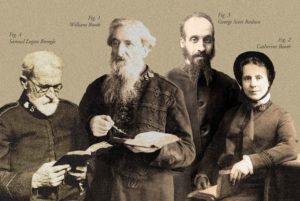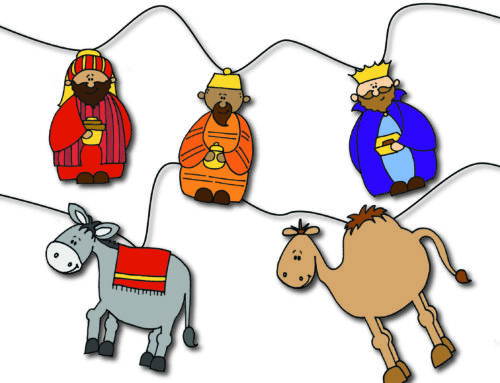 4 Key Salvation Army Biographies
4 Key Salvation Army Biographies
That Uncover Our Treasures
This blog series aims to reintroduce significant pieces of biographical literature that help to understand The Salvation Army’s historical and theological foundations, raised from a reform and revival movement in 19th century England. We will dive into four literary works that each explore key figures of The Salvation Army’s legacy, all of whom contributed to establishing The Army’s identity in terms of who Salvationists are, what they believe in, and what they are called to do. Through these works, we will highlight the influential figures: 1) William Booth (1829-1912), the founder of The Salvation Army, 2) Catherine Booth (1829- 1890), “the Mother of The Salvation Army,” 3) George Scott Railton (1849-1913), “General Booth’s first lieutenant,” and 4) Samuel Logan Brengle (1860-1936), “the Teacher of Holiness.” Other vital figures also come to mind when The Salvation Army first emerged—for instance, Gunpei Yamamuro (1872-1940), the first Asian (Japanese) commissioner,[1] and Bramwell Booth (1856-1929),[2] the second General and eldest son to the Booths. But the four individuals we will take a closer look at truly defined pillars of The Army’s Wesleyan holiness heritage that persevere today.
Part 1: William Booth
Green, Roger J. The Life and Ministry of William Booth: Founder of The Salvation Army. Nashville: Abingdon Press, 2005.
One of the most respected “Salvationist” scholars, Roger J. Green, Professor Emeritus of Biblical and Theological Studies at Gordon College, has provided many necessary scholarly works on the subject of The Salvation Army’s historical and theological heritage including this biographical book of William Booth (1829-1912), the founder and first General of The Salvation Army.
From the distance of traditional hagiographical accounts, Green’s The Life and Ministry of William Booth: Founder of The Salvation Army represents the most reliable, balanced, and objective evaluation of various facets of William Booth’s life and his ministry as the co-founder of the Salvation Army with his wife, Catherine Booth (1829-1890). Like the author’s previously written biography of Catherine Booth,[3] this book serves as an indispensable and painstaking scholarly resource. It guides us to engage a fresh interpretation of the legacy of William Booth’s significant influence and achievement as the prophetic leader of a new movement in the unique socio-religious setting of nineteenth-century Victorian England.
Green describes The Salvation Army’s early self-understanding as a “movement,” not a church in the denominational sense. It is important to note that the early Army was a missional movement, employing the strong military metaphor as an evangelistic strategy towards both the wounded world and the dogmatized church of the nineteenth century Victorian England. Indeed, after Booth named his Christian Mission (1869) “the Salvation Army” in 1878, Booth’s understanding of salvation significantly changed toward not only in personal salvation but in social salvation as well.
Throughout the book, Green provides a balanced and theologically sensitive assessment of the distinct background of William Booth’s Wesleyan connection. He assesses Booth’s theological foundation, as well as his unalloyed zeal and pragmatic vision for the soul-saving mission to the world in light of the nineteenth-century transatlantic revivalism based on the governmental establishment of the quasi-military structure.
The significance of William Booth’s radical support towards the biblical and theological affirmation and practice of the equal authority of women in the religious community is a significant element for contributing to the growth of the movement. Also, Green points out that the backdrop of Booth’s postmillennial faith as an eschatological ground for the task of mission and social change, and his theological inclination towards the pneumatological priority of ecclesiology nourished his wholistic emphasis of Wesleyan view of the doctrine of sanctification which emphasizes not an only personal aspect of holiness but also social and corporate dimensions of sanctifying life.
At the same time, unlike various early versions of William Booth’s hagiographical accounts, Green does not hesitate to unveil the complex and authoritarian character and leadership style of William Booth, not only as of the founder of this newly established mission-oriented ecclesiastical organization but also as the father of his children. His autocratic leadership style caused the dynastic squabbles among his children and eventually led to alienation from three of his children-Ballington, Catherine, and Herbert.
Green has discussed the background of the controversial issue of Booth’s final decision in the abandonment of the traditional practice of the Lord’s Supper and water baptism, which was officiated in 1883. Considering the Salvation Army’s mission-oriented, pneumatological priority of non-sacramental position, Booth’s theological affirmation in the biblical view of “priesthood of all believers” and the officiation by women in the administration of sacraments in supporting the biblical egalitarianism have to be discussed in light of the theological and practical “contextualization” of Booth’s vision towards his reform and revival movement under the flag, named The Salvation Army.
This biography should be used as a valuable and required reading resource for enhancing the scholarly trace of the life and ministry of a complex and remarkable man of God.
[1] See R. David Rightmire, Salvationist Samurai: Gunpei Yamamuro and the Rise of the Salvation Army in Japan (Lanham, MD: The Scarecrow Press, Inc., 1997).
[2] See Catherine Bramwell Booth, Bramwell Booth (London: Rich and Cowan, 1933).
[3] Roger J. Green, Catherine Booth: A Biography of the Cofounder of The Salvation Army (Grand Rapid: Michigan, 1996).
For more in this series, click here
written by Major Young Sung Kim, Territorial Ambassador for Holiness, Spiritual Life Development Department, USA East




